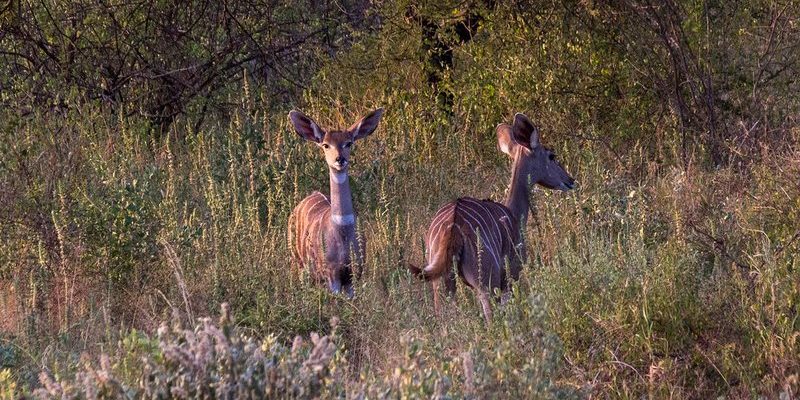
So, what makes the way lesser kudus raise their young so interesting? These creatures are masters of stealth, utilizing their natural surroundings to keep their calves safe from predators while teaching them the ropes of survival. Picture a tender dance between nurture and nature, where every step and breath matters. In this article, I’ll walk you through the incredible journey of lesser kudus as they rear their young, highlighting their fascinating behaviors and strategies.
The Birth of a Kudu Calf
The adventure begins when a female lesser kudu gives birth. Typically, a single calf is born after a gestation period of about seven months. Here’s the thing: when the time comes, the mother frequently seeks a secluded spot—thick brush or dense foliage—where she feels safe. This choice is crucial; it hides her newborn from potential predators like lions or hyenas, who are always on the lookout for an easy meal.
Once the calf is born, it’s not just about celebrating new life. The mother instinctively knows that she must keep her baby hidden for a while. Young lesser kudus are born with a mottled coat that provides excellent camouflage against the forest floor, making it harder for predators to spot them. For the first few weeks, the calf stays tucked away, while the mother ventures out to feed. This system allows her to regain strength without putting her little one at risk.
Mother Kudu’s Vigilance
Lesser kudus are incredibly protective mothers. After giving birth, the mother remains close to her calf, but she often separates herself to keep the little one hidden. Picture this: she has a sharp eye and acute hearing, constantly monitoring the area for danger. If she senses a threat, she can quickly return to her calf, guiding it to safety.
During this time, the mother communicates with her calf using soft bleats. It’s a gentle way of reminding the calf to stay put while she forages. This vigilance isn’t just about being overprotective—it’s a necessary strategy in a world where danger lurks at every corner. Honestly, it’s a tough job, but lesser kudus have evolved to handle it remarkably well.
Feeding and Nutrition for the Young
As the calf grows, so does its need for nourishment. Initially, it relies on its mother’s milk, which is rich in nutrients essential for growth. You might be wondering how long this lasts. Typically, calves will nurse for about four to six months, gradually transitioning to solid food. This is where the mother plays a crucial role.
When the calf is about 3–4 weeks old, the mother starts introducing it to vegetation like leaves, shoots, and tender grasses. She leads it to safe foraging spots, teaching it what to eat and what to avoid. This is crucial not just for survival, but also for the calf’s development as it learns to navigate its environment. Each nibble is a lesson in survival, a stepping stone toward independence.
The Importance of Social Learning
As lesser kudu calves grow, they become curious about their surroundings. This curiosity is not just natural; it’s a part of their social learning process. Young kudus often observe their mothers and other adult kudus to learn important survival skills. They watch how their mothers react to dangers and interact with other members of the herd.
Here’s the captivating part: while female kudus are usually the primary caregivers, they also learn from one another. This communal atmosphere fosters a sense of community that’s vital for their survival. The young ones mimic the behaviors of the adults, gaining critical knowledge about finding food, identifying threats, and navigating their environment. It’s almost like a classroom in the wild, filled with invaluable lessons.
Independence and Leaving the Nest
As the months pass, the calf begins to gain independence. By the time they reach 6–8 months, they’re pretty much ready to venture out on their own. However, this doesn’t happen overnight. The mother gradually encourages her young one to explore while still maintaining a watchful eye. It’s sort of like when your parent lets you ride your bike down the street alone for the first time—there’s freedom, but also a safety net.
Eventually, the young kudu will start joining other herds or even forming small bachelor groups. This transition is crucial for their survival. Socialization with other kudus helps them develop important skills and prepares them for adult life, where they’ll need to fend for themselves and find their own place within the broader ecosystem.
Facing the Challenges of Survival
While lesser kudus are well-equipped to raise their young, the challenges they face are significant. Habitat loss and rising predator populations can drastically affect their ability to rear calves successfully. Climate change also plays a role, altering food availability and water sources. The mother kudu’s instinct to hide her calf may be more critical now than ever.
In the wild, not every calf will survive to adulthood. Predators, especially during the early months, can take a heavy toll. However, those that do make it often grow into robust, adaptable adults, carrying forward the lessons they’ve learned. Survival is a blend of instinct, learned behavior, and a bit of luck in the wild.
Raising young in the wild is no small feat, and lesser kudus illustrate this beautifully. From the moment a calf is born, its mother embarks on a journey filled with challenges and triumphs. Through keen vigilance, nurturing, and social learning, kudus equip their young with the skills necessary for survival.
In a world where the balance of nature is constantly shifting, lesser kudus remind us of the delicate interplay between care and independence. Whether you’re fascinated by wildlife or simply curious about parenting in the animal kingdom, lesser kudus provide an intriguing look at how nature fosters growth and resilience. So next time you think about the wild, remember the kudus and their remarkable journey of raising the next generation.

